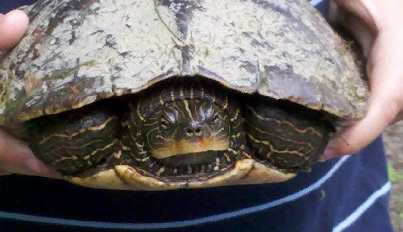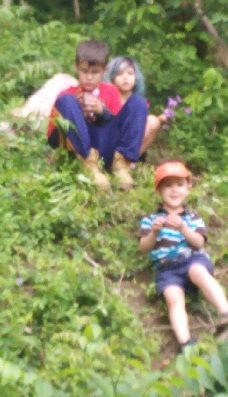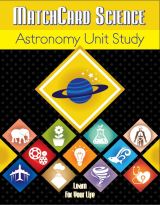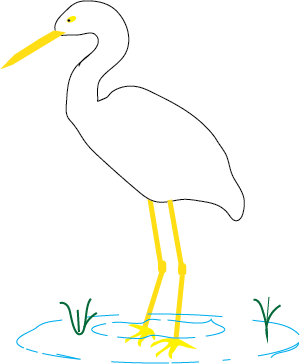Nature Walk
A nature walk is one of the best ways to study nature.

What will you find on your nature walk?
Why Study Nature?
What is the educational value of a nature walk?Did you ever notice in literature that the naturalists are often the wise, calm, observant type?
Studying nature sharpens a child's observational skills.
It also creates a respect for nature and other living things.
You have probably heard the expression "Stop and smell the roses." Seeing and experiencing the natural world around us actually helps us get our own lives and perspectives straight.
Planning Your Walk

Some families plan their nature walk with kids weeks in advance, and some choose to do it spontaneously when beautiful weather creates an irresistable invitation. Even if you are the more spontaneous type, you can be prepared with the following ideas:
- List of locations you would like to explore
- Directions (if not already known)
- Water bottles, sun tan lotion, walking shoes, etc.
- Choose your record keeping
Record Keeping?
Here are some of our favorite ways of recording our nature walks. We would love to have you share some of yours as well (see below).- Collect specimens - You can have a nature box, or even a display on a small table of items you have collected. Flowers can be pressed, pine cones arranged, etc. We have had the skeleton of a snake and the jawbone of a squirrel (I think its a squirrel) for years.
- Take photographs - Some places don't allow flowers to be picked; and some parts of nature cannot be taken home. But I have never seen a park that didn't allow a camera. This could double up as your photography lesson as well.
- Drawing and sketching - Our homeschool predecessors from the 1900's perfected this as part of the education of the genteel class. Instead of a camera, grab a sketch pad and a set of charcoal pencils. Any other artistic media will also work.
- Prose and Poetry - For our budding authors, nothing may inspire writing material more than nature itself. Did you ever notice how often novels describe the outdoor scenery? Encourage the students to go a little further in their descriptive writing.
However you decide to record your nature walk, do consider keeping a small nature notebook. Don't expect to fill a 70 page spiral notebook, unless you do lots of walks. However, five pages to slip into your binder for the year would be enough to document their progress in understanding nature.
Here's A Thought:
Would you rather explore the same location over the course of a year using different media (for instance - photography.) Or, would you prefer to use the same media for a year, and go to different locations?
The Focus of Your Nature Walk
You cannot study everything in one trip. Here are different aspects of nature you may wish to focus on. You might focus on one or two (three at the most) in a single outing.Wild Flowers
Compare size, shape, color. Do they recognize any?Notice the petals and the sepals and the leaves.
Notice the pollen. Would they be pollinated by insects or the wind?
Trees
Notice these aspects of trees:- The shape of the leaves
- The shape of the entire tree
- The type of bark
- Types of seeds (depending on the time of year)
Which type of tree is most prevalent in this park or area?
Leaves
Another leaf study would include leaves of bushes and vines.Don't forget the rule: "Leaves of three - let them be." Alert your kids to poison ivy, poison sumac, and poison oak.
Insects
Well, of course, we all know ants, bees, and butterflies. Here are some other ways to focus on insects during your nature walk.- Sit still and watch them. How do they move? Do they go near other insects?
- Do you consistently see a certain type of insect on a certain type of plant? Make deductions.
- Can you use a field guide to identify the unknown insects? Or a field guide to more thoroughly differentiate one type of bee from another.
- Notice any camouflauge?
Birds
Before looking, stop and listen.Better yet, sit down, close your eyes and really listen.
How many different types of bird song do you hear?
How many different individual birds of the same type do you hear.
Imagine you are sitting in the middle of a clock, facing 12:00. Point to which direction (time on the clock) you are hearing birds sing. Don't actually talk. Just point with your finger. Or, if you have a piece of paper, mark it down.
Tap your fore finger and thumb together in time with the birds' singing to identify the number of "syllables".
Can you see any of your birds? Can you identify them with a field guide?
Other Nature Sounds
While listening to birds, become aware of other nature sounds.- List the different sounds you hear.
- How does the weather affect the sounds around you?
Moss, vines, grass, shrubs
These provide a more advanced study than trees and flowers. However, a naturalist is very aware of them.- Vines grow on which type of trees?
- Which direction is the moss growing?
- Where does the grass grow? Where is there no grass?
- How do the shrubs share the space with trees and other plants?
Water
It won't be too long before you encounter water. Is it a puddle, creek, stream, river, lake or pond?- How does this body of water communicate with the ocean?
- How do the plants change as you get close to the edge of the water?
- What life do you see along the edges?
- Does the water seem to have a "mood?"
Soil
- What are you standing on?
- What is it made out of?
MatchCard Science
How To Use MatchCards

Download the FREE MatchCard Science Instructor's Guide and see how MatchCards can make building their science knowledge base fun.
Astronomy Unit Study

Explore the universe with the MatchCard Science Astronomy Unit Study..
12 Science Unit Studies

Chemistry is only one of twelve complete unit studies for kids in 3rd to 8th grade.
Comprehensive objectives, hands-on projects, suggested science fair experiments, and the fun game-like MatchCards keep them interested in learning science. See all twelve MatchCard Science Unit Studies.


About Our Site
Hands-On Learning













